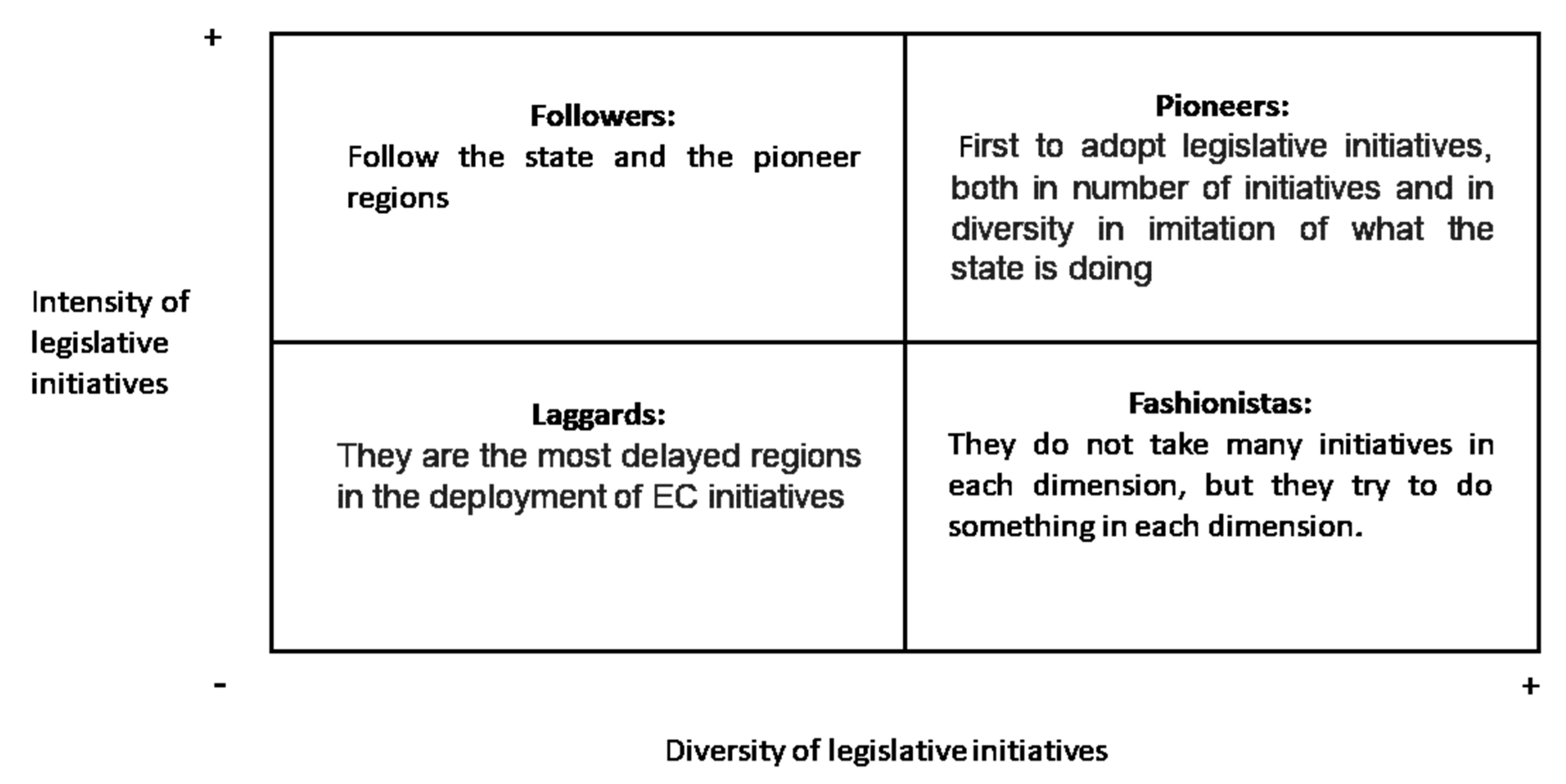The Role of Institutional Engagement at the Macro Level in Pushing the Circular Economy in Spain and Its Regions
Abstract
1. Introduction
2. Legislative Analysis: EU Legislation on the Circular Economy
3. Institutional Theory and the Adoption of Environmental Practices
4. EU CE Monitoring Framework
5. Methods
5.1. Data of Analysis: Spain’s Positioning in the Circular Economy; Development of Policies and Norms
5.2. Data Gathered and Analysis
6. Results and Discussion
6.1. CE in Spain: Results
6.2. Regional Contributions to the CE in Spain: Results
7. Conclusions
Author Contributions
Funding
Conflicts of Interest
References
- Ruiz-Real, J.L.; Uribe-Toril, J.; De Pablo Valenciano, J.; Gázquez-Abad, J.C. Worldwide research on circular economy and environment: A bibliometric analysis. Int. J. Environ. Res. Public Health 2018, 15, 2699. [Google Scholar] [CrossRef] [PubMed]
- Uribe-Toril, J.; Ruiz-Real, J.L.; Milán-García, J.; De Pablo Valenciano, J. Energy, economy, and environment: A worldwide research update. Energies 2019, 12, 1120. [Google Scholar] [CrossRef]
- Korhonen, J.; Honkasalo, A.; Seppälä, J. Circular economy: The concept and its limitations. Ecol. Econ. 2018, 143, 37–46. [Google Scholar] [CrossRef]
- WEF. The Travel & Tourism Competitiveness Report 2019; WEF: Geneva, Switzerland, 2019. [Google Scholar]
- Rogers, K.W.; Purdy, L.; Safayeni, F.; Duimering, P.R. A supplier development program: Rational process or institutional image construction? J. Oper. Manag. 2007, 25, 556–572. [Google Scholar] [CrossRef]
- Font, X.; Bonilla-Priego, M.J.; Kantenbacher, J. Trade associations as corporate social responsibility actors: An institutional theory analysis of animal welfare in tourism. J. Sustain. Tour. 2019, 27, 118–138. [Google Scholar] [CrossRef]
- Kauppi, K. Extending the use of institutional theory in operations and supply chain management research: Review and research suggestions. Int. J. Oper. Prod. Manag. 2013, 33, 1318–1345. [Google Scholar] [CrossRef]
- Liang, H.G.; Saraf, N.; Hu, Q.; Xue, Y.J. Assimilation of enterprise systems: The effect of institutional pressures and the mediating role of top management. Mis Q. 2007, 31, 59–87. [Google Scholar] [CrossRef]
- Krell, K.; Matook, S.; Rohde, F. The impact of legitimacy-based motives on IS adoption success: An institutional theory perspective. Inf. Manag. 2016, 53, 683–697. [Google Scholar] [CrossRef]
- Zhu, Q.; Geng, Y.; Fujita, T.; Hashimoto, S. Green supply chain management in leading manufacturers. Manag. Res. Rev. 2010, 33, 380–392. [Google Scholar] [CrossRef]
- Simpson, D. Institutional pressure and waste reduction: The role of investments in waste reduction resources. Int. J. Prod. Econ. 2012, 139, 330–339. [Google Scholar] [CrossRef]
- Chen, X.; Yi, N.; Zhang, L.; Li, D. Does institutional pressure foster corporate green innovation? Evidence from China’s top 100 companies. J. Clean. Prod. 2018, 188, 304–311. [Google Scholar] [CrossRef]
- European Commission. Communication from the Commission to the European Parliament, the Council, the European Economic and Social Committee, and the Committee of the Regions, “Closing the Loop—An EU Action Plan for the Circular Economy”; European Commission: Brussels, Belgium, 2015. [Google Scholar]
- European Commission. Communication from the Commission to the European Parliament, the Council, the European Economic and Social Committee and the Committee of the Regions on a Monitoring Framework for the Circular Economy; European Commission: Brussels, Belgium, 2018. [Google Scholar]
- Lu, Y.; Zhao, C.; Xu, L.; Shen, L. Dual institutional pressures, sustainable supply chain practice and performance outcome. Sustainability 2018, 10, 3247. [Google Scholar] [CrossRef]
- Wang, P.; Che, F.; Fan, S.; Gu, C. Ownership governance, institutional pressures and circular economy accounting information disclosure. Chin. Manag. Stud. 2014, 8, 487–501. [Google Scholar] [CrossRef]
- Llach, J.; Alonso-Almeida, M.D.M.; García-Castellví, A.; Bagur-Femenias, L. A fresh approach to context influence, development and performance in environmental management. Bus. Strategy Environ. 2015, 24, 855–872. [Google Scholar] [CrossRef]
- Zeng, H.; Chen, X.; Xiao, X.; Zhou, Z. Institutional pressures, sustainable supply chain management, and circular economy capability: Empirical evidence from Chinese eco-industrial park firms. J. Clean. Prod. 2017, 155, 54–65. [Google Scholar] [CrossRef]
- Gunningham, N.; Rees, J. Industry self-regulation: An institutional perspective. Law Policy 1997, 19, 363–414. [Google Scholar] [CrossRef]
- DiMaggio, P.J.; Powell, W. The iron cage revisited: Institutional isomorphism and collective rationality in organizational fields. Am. Sociol. Rev. 1983, 42, 147–160. [Google Scholar] [CrossRef]
- Huo, B.; Han, Z.; Zhao, X.; Zhou, H.; Wood, C.H.; Zhai, X. The impact of institutional pressures on supplier integration and financial performance: Evidence from China. Int. J. Prod. Econ. 2013, 146, 82–94. [Google Scholar] [CrossRef]
- Lin, R.J.; Sheu, C. Why do firms adopt/implement green practices? An institutional theory perspective. Procedia-Soc. Behav. Sci. 2012, 57, 533–540. [Google Scholar] [CrossRef]
- Zhu, Q.; Sarkis, J.; Lai, Y. Green supply chain management in China: Pressure, practices, and performance within the automobile industry. J. Clean. Prod. 2007, 25, 1041–1052. [Google Scholar] [CrossRef]
- Wu, G.; Ding, J.; Chen, P. The effects of GSCM drivers and institutional pressures on GSCM practices in Taiwan’s textile and apparel industry. Int. J. Prod. Econ. 2012, 135, 618–636. [Google Scholar] [CrossRef]
- Salguero-Puerta, L.; Leyva-Díaz, J.C.; Cortés-García, F.J.; Molina-Moreno, V. Sustainability indicators concerning waste management for implementation of the circular economy model on the University of Lome (Togo) Campus. Int. J. Environ. Res. Public Health 2019, 16, 2234. [Google Scholar] [CrossRef] [PubMed]
- Ranta, V.; Aarikka-Stenroos, L.; Ritala, P.; Mäkinen, S.J. Exploring institutional drivers and barriers of the circular economy: A cross-regional comparison of China, the US, and Europe. Resour. Conserv. Recycl. 2018, 135, 70–82. [Google Scholar] [CrossRef]
- Williams, Z.; Lueg, J.E.; Taylor, R.D.; Cook, R.L. Why all the changes? An institutional theory approach to exploring the drivers of supply chain security (SCS). Int. J. Phys. Distrib. Logist. Manag. 2009, 39, 595–618. [Google Scholar] [CrossRef]
- Haunschild, P.R.; Miner, A.S. Modes of interorganizational imitation: The effects of outcome salience and uncertainty. Adm. Sci. Q. 1997, 42, 472–500. [Google Scholar] [CrossRef]
- Miemczyk, J. An exploration of institutional constraints on developing end-of-life product recovery capabilities. Int. J. Prod. Econ. 2008, 115, 272–282. [Google Scholar] [CrossRef]
- Available online: http://ec.europa.eu/eurostat/web/circular-economy (accessed on 8 February 2020).
- Available online: http://ec.europa.eu/eurostat/web/circular-economy/indicators/monitoringframework (accessed on 8 February 2020).
- Fundación Cotec. Situación y Evolución de la Economia Circular en España. 2017. Available online: www.cotec.es (accessed on 2 April 2019).
- Lieder, M.; Rashid, A. Towards circular economy implementation: A comprehensive review in context of manufacturing industry. J. Clean. Prod. 2016, 115, 36–51. [Google Scholar] [CrossRef]
- Avdiushchenko, A.; Zając, P. Circular economy indicators as a supporting tool for European regional development policies. Sustainability 2019, 11, 3025. [Google Scholar] [CrossRef]
- Rogers, E.M. Diffusion of Innovations, 3rd ed.; The Free Press: New York, NY, USA, 1983. [Google Scholar]
- Zhang, C.; Dhaliwal, J. An investigation of resource-based and institutional theoretic factors in technology adoption for operations and supply chain management. Int. J. Prod. Econ. 2009, 120, 252–269. [Google Scholar] [CrossRef]
- Frantzeskaki, N.; Kabisch, N. Designing a knowledge co-production operating space for urban environmental governance—Lessons from Rotterdam, The Netherlands and Berlin, Germany. Environ. Sci. Policy 2016, 62, 90–98. [Google Scholar] [CrossRef]
- Kirchherr, J.; Piscicelli, L.; Bour, R.; Kostense-Smit, E.; Muller, J.; Huibrechtse-Truijens, A.; Hekkert, M. Barriers to the circular economy: Evidence from the European Union (EU). Ecol. Econ. 2018, 150, 264–272. [Google Scholar] [CrossRef]
- LE Europe; VVA Europe; IPSOS; ConPolicy; Trinomics. Behavioural Study on Consumers’ Engagement in the Circular Economy; European Commission, Directorate-General for Justice and Consumers: Brussels, Belgium, 2018. [Google Scholar]
- Wang, M.; Liu, P.; Gu, Z.; Cheng, H.; Li, X.A. Scientometric Review of Resource Recycling Industry. Int. J. Environ. Res. Public Health 2019, 16, 4654. [Google Scholar] [CrossRef] [PubMed]
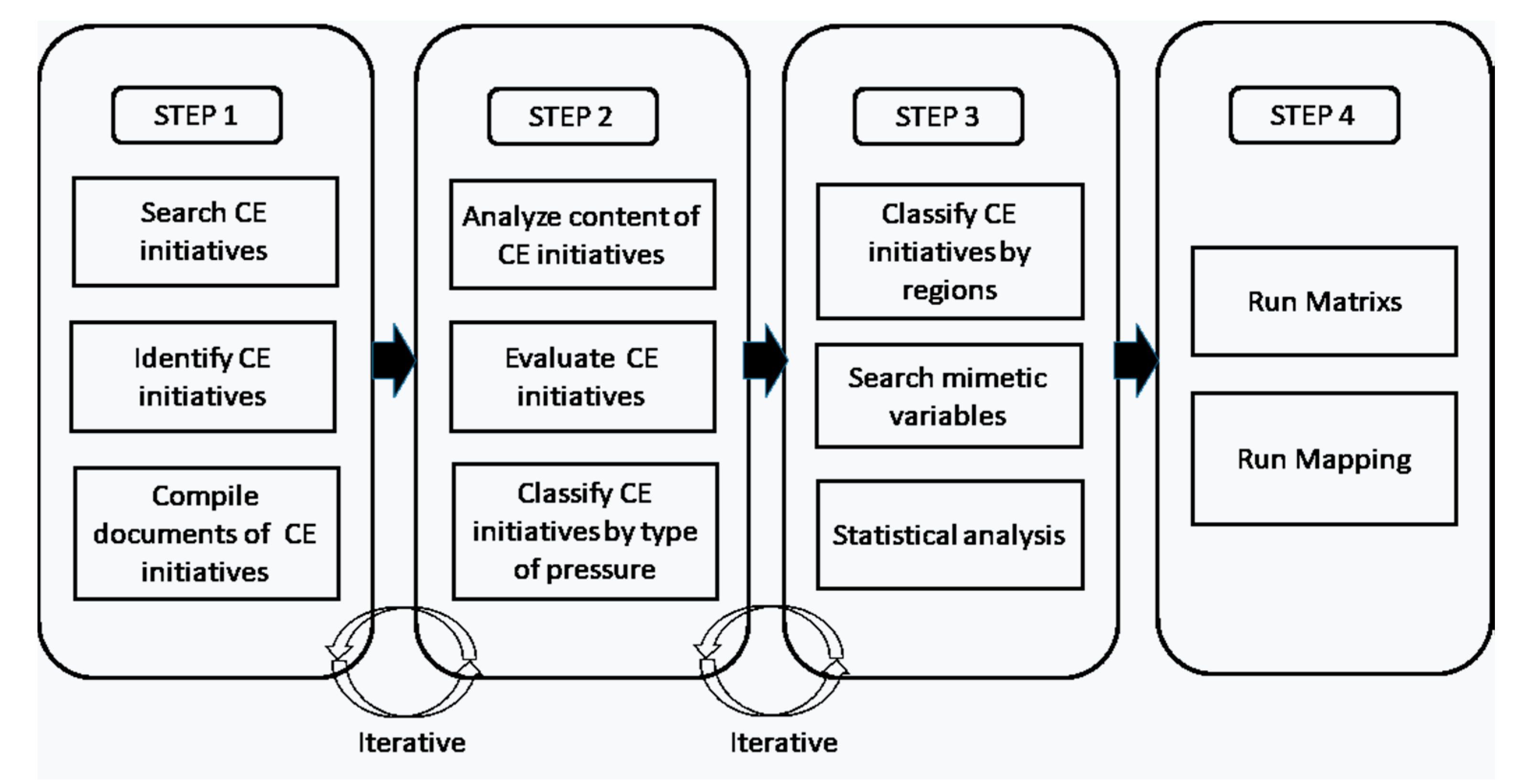
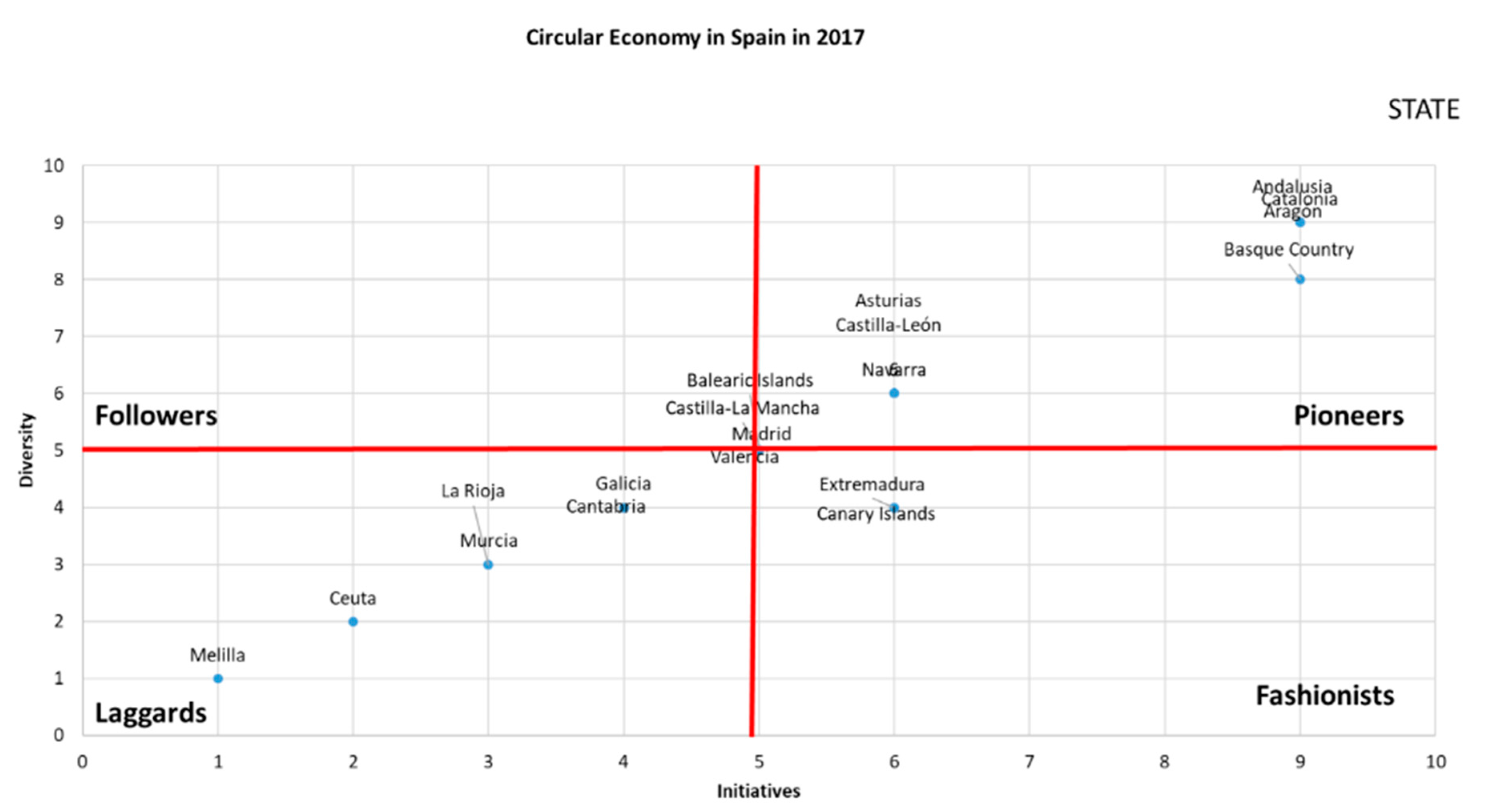

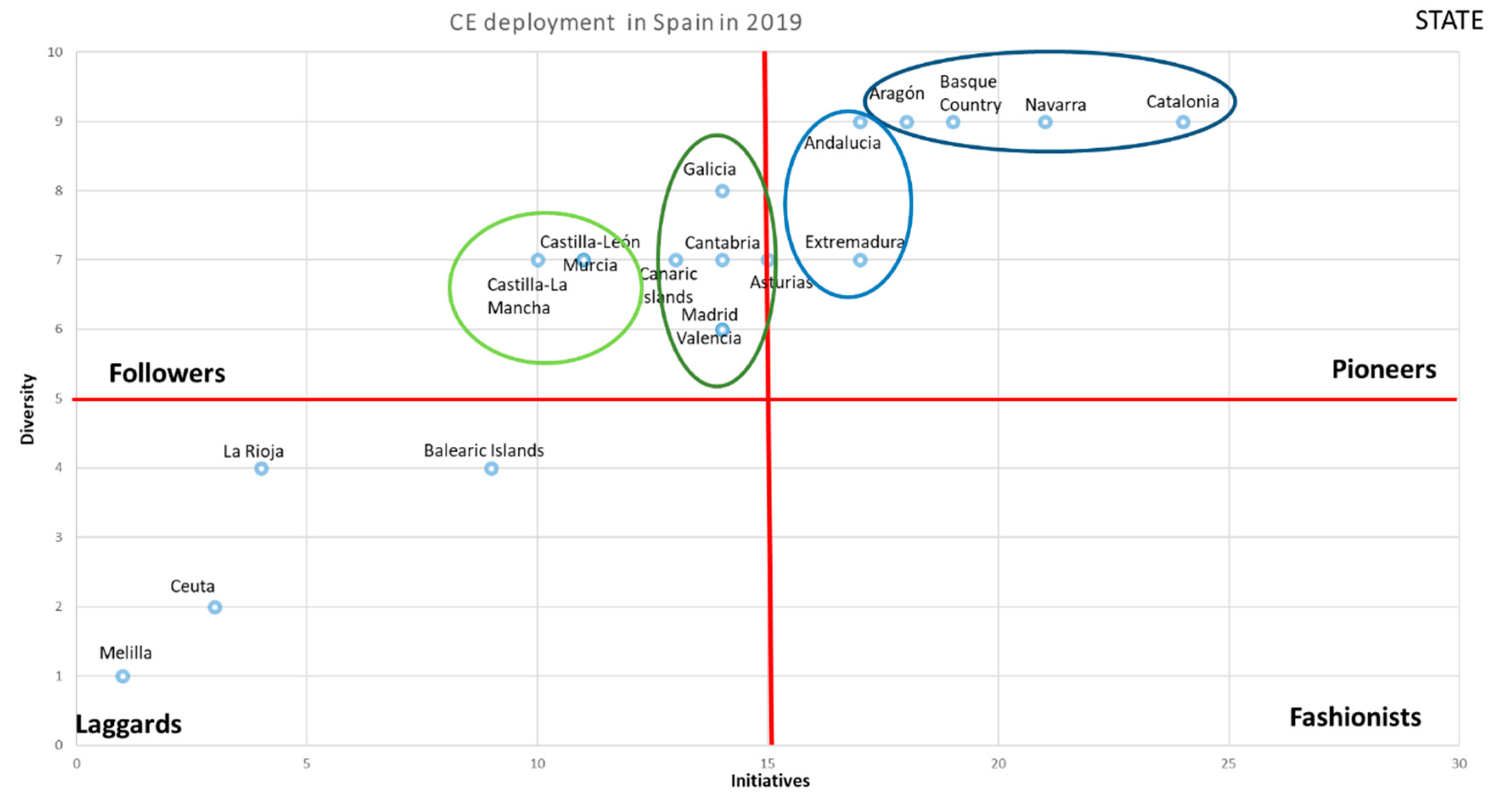
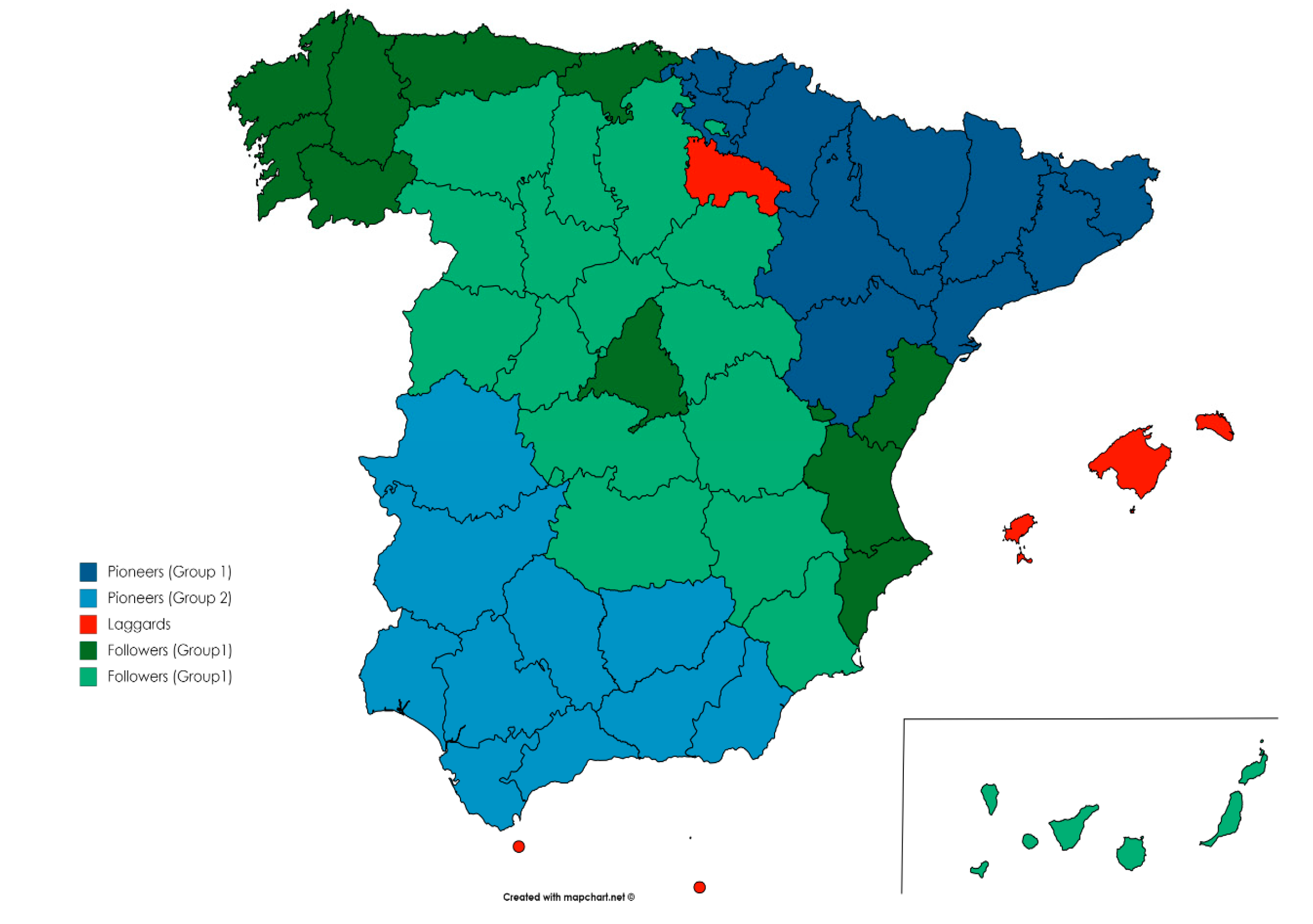
| Title of the Initiative | Type of Initiative | Publication Date | Goals | Link |
|---|---|---|---|---|
| Roadmap to a resource efficient Europe | Communication from the Commission to the European Parliament, the Council, the European Economic and Social Committee and the Committee of the Regions | 20/09/2011 | Provide a stable perspective for transforming the economy in the EU | https://eur-lex.europa.eu/legal-content/ES/TXT/PDF/?uri=CELEX:52011DC0571&from=EN |
| Closing the loop. An EU action plan for the circular economy | Communication from the Commission to the European Parliament, the Council, the European Economic and Social Committee and the Committee of the Regions | 02/12/2015 | Encourage member states to fulfill the commitments of the 2030 Agenda | https://eur-lex.europa.eu/resource.html?uri=cellar:8a8ef5e8-99a0-11e5-b3b7-01aa75ed71a1.0012.02/DOC_1&format=PDF |
| Next steps for a sustainable European future: European action for sustainability | Communication from the Commission to the European Parliament, the Council, the European Economic and Social Committee and the Committee of the Regions | 22/11/2016 | Confirm the EU’s commitment to sustainable development and the achievement of the 17 Sustainable Development Goals (SDGs), describing the initiatives that the EU countries are implementing to reach the 17 SDGs | https://eur-lex.europa.eu/legal-content/EN/TXT/PDF/?uri=CELEX:52016DC0739&from=EN |
| Key European action supporting the 2030 Agenda and the Sustainable Development Goals | Commission Staff Working Document. Accompanying the Document Next Steps for a Sustainable European Future: European Union Action for Sustainability | https://eur-lex.europa.eu/legal-content/EN/TXT/PDF/?uri=CELEX:52016SC0390&from=en | ||
| Monitoring framework for the circular economy | Communication from the Commission to the European Parliament, the Council, the European Economic and Social Committee and the Committee of the Regions | 16/01/2018 | Provides an analysis of how Member States are implementing the measures aimed at implementing a CE in the EU and what results are being achieved | https://eur-lex.europa.eu/legal-content/EN/TXT/PDF/?uri=CELEX:52018DC0029&from=EN |
| A European strategy for plastics in a circular economy | Communication from the Commission to the European Parliament, the Council, the European Economic and Social Committee and the Committee of the Regions | 16/01/2018 | Achieve a circular economy of plastic, promote the reuse of water, encourage sustainable food systems, and reduce food waste | https://eur-lex.europa.eu/resource.html?uri=cellar:2df5d1d2-fac7-11e7-b8f5-01aa75ed71a1.0001.02/DOC_1&format=PDF |
| A European strategy for plastics in a circular economy | Commission staff working document. Accompanying the document a European strategy for plastics in a circular economy | https://eur-lex.europa.eu/legal-content/EN/TXT/PDF/?uri=CELEX:52018SC0016&from=EN | ||
| Directive (UE) 2018/849 | Directive of the European Parliament and of the Council amending Directives 2000/53/EC on end-of-life vehicles, 2006/66/EC on batteries and accumulators and waste batteries and accumulators, and 2012/19/EU on waste electrical and electronic equipment | 30/05/2018 | Update previous directives on vehicles at the end of their useful life, on batteries and accumulators and their waste, and, finally, on waste electrical and electronic equipment | https://eur-lex.europa.eu/legal-content/ES/TXT/?qid=1555698440185&uri=CELEX:32018L0849 |
| Directive (UE) 2018/850 | Directive of the European Parliament and of the Council amending Directive 1999/31/EC on the landfill of waste | 30/05/2018 | Update the previous directive on landfills of waste | https://eur-lex.europa.eu/legal-content/ES/TXT/?qid=1555698440185&uri=CELEX:32018L0850 |
| Directive (UE) 2018/851 | Directive of the European Parliament and of the Council amending Directive 2008/98/EC on waste | 30/05/2018 | Update the previous directive on waste | https://eur-lex.europa.eu/legal-content/ES/TXT/?qid=1555698440185&uri=CELEX:32018L0851 |
| Directive (UE) 2018/852 | Directive of the European Parliament and of the Council amending Directive 94/62/EC on packaging and packaging waste | 30/05/2018 | Update the previous directive on packaging and packaging waste | https://eur-lex.europa.eu/legal-content/ES/TXT/?qid=1555698440185&uri=CELEX:32018L0852 |
| A sustainable bioeconomy for Europe: Strengthening the connection between economy, society and the environment | Communication from the Commission to the European Parliament, the Council, the European Economic and Social Committee and the Committee of the Regions | 11/10/2018 | Update the bioeconomy strategy of 2012, setting 14 specific actions | https://eur-lex.europa.eu/legal-content/EN/TXT/PDF/?uri=CELEX:52018DC0673&from=EN |
| Towards a sustainable Europe by 2030 | Reflection paper | 30/01/2019 | The questions raised in this reflection paper are intended to inform a debate with a view to inspiring the debate on the future of Europe, the preparation of the European Union’s strategic agenda 2019–2024, and the priority setting of the next European Commission | https://ec.europa.eu/commission/sites/beta-political/files/rp_sustainable_europe_30-01_en_web.pdf |
| The implementation of the circular economy action plan | Report from the Commission to the European Parliament, the Council, the European Economic and Social Committee and the Committee of the Regions | 04/03/2019 | This report presents the main results of implementing the circular economy action plan | https://eur-lex.europa.eu/legal-content/EN/TXT/PDF/?uri=CELEX:52019DC0190&from=ES |
| Environmental implementation review 2019: A Europe that protects its citizens and enhances their quality of life | Communication from the Commission to the European Parliament, the Council, the European Economic and Social Committee and the Committee of the Regions | 04/04/2019 | The Environmental implementation review identify the causes of implementation gaps and addressing systemic obstacles to environmental integration across policy sectors | https://eur-lex.europa.eu/resource.html?uri=cellar:fcfafdcd-0abf-11ea-8c1f-01aa75ed71a1.0013.02/DOC_1&format=PDF |
| United in delivering the energy union and climate action. Setting the foundations for a successful clean energy transition | Communication from the Commission to the European Parliament, the Council, the European Economic and Social Committee and the Committee of the Regions | 18/06/2019 | This communication analyses the draft national energy and climate plans (NECPs) and looks at their aggregated effects in reaching the EU energy union objectives and 2030 targets | https://eur-lex.europa.eu/legal-content/EN/TXT/PDF/?uri=CELEX:52019DC0285&rid=1 |
| The European green deal | Communication from the Commission to the European Parliament, the European Council, the Council, the European Economic and Social Committee and the Committee of the Regions | 11/12/2019 | The European green deal is a new growth strategy that aims to transform the EU into a fair and prosperous society, with a modern, resource-efficient, and competitive economy where there are no net emissions of greenhouse gases in 2050, and where economic growth is decoupled from resource use | https://eur-lex.europa.eu/resource.html?uri=cellar:b828d165-1c22-11ea-8c1f-01aa75ed71a1.0002.02/DOC_1&format=PDF |
| Annual sustainable growth strategy 2020 | Communication from the Commission to the European Parliament, the Council, the European Central Bank, the European Economic and Social Committee, the Committee of the Regions and the European Investment Bank | 17/12/2019 | This communication defends that the European green deal puts sustainability in all of its senses: environment, productivity, stability and fairness | https://eur-lex.europa.eu/legal-content/EN/TXT/PDF/?uri=CELEX:52019DC0650&qid=1581257527301&from=EN |
| Year | EU | Year | EU | |
|---|---|---|---|---|
| Production and Consumption | ||||
| EU self-sufficiency for raw materials (percentage) | 2016 | 36.4 | N/A | N/A |
| Generation of municipal waste (kg per capita) | 2018 | 488 | 2011 | 498 |
| Food waste (million ton) | 2016 | 80 | 2012 | 81 |
| Waste Management | ||||
| Recycling rate of municipal waste (percentage) | 2018 | 47 | 2011 | 39.6 |
| Recycling rate of overall packaging (percentage) | 2017 | 67 | 2012 | 64.7 |
| Recycling rate of e-waste (percentage) | 2016 | 41.4 | 2011 | 28.7 |
| Recycling of bio-waste (kg per capita) | 2018 | 83 | 2011 | 69 |
| Recovery rate of construction and demolition waste (percentage) | 2016 | 89 | 2010 | 78 |
| Secondary Raw Materials | ||||
| End-of-life recycling input rates (EOL-RIRs) (percentage) | 2016 | 12.4 | N/A | N/A |
| Circular material use rate (percentage) | 2017 | 11.7 | 2010 | 10.8 |
| Competitiveness and Innovation | ||||
| Gross investment in tangible goods (percentage of gross domestic product (GDP) at current prices) | 2017 | 0.12 | 2013 | 0.11 |
| Number of persons employed (percentage of total employment) | 2017 | 1.69 | 2012 | 1.68 |
| Number of patents related to recycling and secondary raw materials (per million inhabitants) | 2015 | 0.70 | 2009 | 0.60 |
| Country with Best Value | Value | Year | |
|---|---|---|---|
| Production and Consumption | |||
| Generation of municipal waste (kg per capita) | Romania | 272 | 2018 |
| Waste Management | |||
| Recycling rate of municipal waste (percentage) | Germany | 67.3 | 2018 |
| Recycling rate of overall packaging (percentage) | Belgium | 83.8 | 2017 |
| Recycling rate of e-waste (percentage) | Croatia | 81.3 | 2017 |
| Recycling of bio-waste (kg per capita) | Austria | 187 | 2018 |
| Recovery rate of construction and demolition waste (percentage) | Luxembourg, The Netherlands, and Malta | 100 | 2016 |
| Secondary Raw Materials | |||
| Circular material use rate (percentage) | The Netherlands | 29.9 (e) | 2017 |
| Competitiveness and Innovation | |||
| Gross investment in tangible goods (percentage of gross domestic product at current prices) | Latvia | 0.35 | 2017 |
| Number of persons employed (percentage of total employment) | Latvia | 2.82 | 2017 |
| Number of patents related to recycling and secondary raw materials (per million inhabitants) | Luxembourg | 3.51 | 2015 |
| Year | EU | SPAIN | ||
|---|---|---|---|---|
| Production and Consumption | ||||
| Generation of municipal waste (kg per capita) | 2018 | 488 | 475 | ↑ |
| Waste Management | ||||
| Recycling rate of municipal waste (percentage) | 2018 | 47 | 36 | ↓ |
| Recycling rate of overall packaging (percentage) | 2017 | 67 | 68.5 | ↑ |
| Recycling rate of e-waste (percentage) | 2017 | 41.4 | 41 | ↓ |
| Recycling of bio-waste (kg per capita) | 2018 | 83 | 84 | ↑ |
| Recovery rate of construction and demolition waste (percentage) | 2016 | 89 | 79 | ↓ |
| Secondary Raw Materials | ||||
| Circular material use rate (percentage) | 2017 | 11.7 | 7.4 | ↓ |
| Competitiveness and Innovation | ||||
| Gross investment in tangible goods (percentage of gross domestic product (GDP) at current prices) | 2017 | 0.12 | 0.10 | ↓ |
| Number of persons employed (percentage of total employment) | 2017 | 1.69 | 2.04 | ↑ |
| Number of patents related to recycling and secondary raw materials (per million inhabitants) | 2015 | 0.70 | 0.43 | ↓ |
| Year | UE | Croatia | Place | Cyprus | Place | France | Place | Greece | Place | Italy | Place | Malta | Place | Portugal | Place | Slovenia | Place | Spain | Place | |
|---|---|---|---|---|---|---|---|---|---|---|---|---|---|---|---|---|---|---|---|---|
| Production and Consumption | ||||||||||||||||||||
| Generation of municipal waste (kg. per capita) | 2018 | 488 | 432 | 1 | 637 | 9 | 527 | 7 | 504 | 6 | 499 | 4 | 604 | 8 | 508 | 6 | 486 | 3 | 475 | 2 |
| Waste Management | ||||||||||||||||||||
| Recycling rate of municipal waste (percentage) | 2018 | 47 | 25.3 | 6 | 16.1 | 8 | 44 | 3 | 18.9 | 7 | 49.8 | 2 | 6.5 | 9 | 28.9 | 5 | 58.9 | 1 | 36 | 4 |
| Recycling rate of overall packaging (percentage) | 2017 | 67 | 50.5 | 8 | 64.6 | 6 | 68.1 | 4 | 68.6 | 2 | 66.9 | 5 | 39.7 | 9 | 55.3 | 7 | 70.1 | 1 | 68.5 | 3 |
| Recycling rate of e-waste (percentage) | 2017 | 41.4 | 81.3 | 1 | 23.1 | 8 | 36.6 | 4 | 32.9 | 7 | 34.4 | 5 | 10.3 | 9 | 43.5 | 2 | 33.9 | 6 | 41 | 3 |
| Recycling of bio-waste (kg per capita) | 2018 | 83 | 12 | 7 | 12 | 7 | 100 | 2 | 21 | 6 | 105 | 1 | 0 | 9 | 85 | 3 | 79 | 45 | 84 | 4 |
| Recovery rate of construction and demolition waste (percentage) | 2016 | 89 | 76 | 7 | 57 | 9 | 71 | 8 | 88 | 5 | 98 | 2 | 100 | 1 | 97 | 4 | 98 | 2 | 79 | 6 |
| Secondary Raw Materials | ||||||||||||||||||||
| Circular material use rate (percentage) | 2017 | 11.7 | 5.1 | 6 | 2.2 | 8 | 18.6 | 1 | 2.4 | 7 | 17.7 | 2 | 6.7 | 5 | 1.8 | 9 | 8.5 | 3 | 7.4 | 4 |
| Competitiveness and Innovation | ||||||||||||||||||||
| Gross investment in tangible goods (percentage of gross domestic product at current prices) | 2017 | 0.12 | 0.12 | 1 | 0.12 | 1 | 0.11 | 4 | 0.05 | 7 | 0.09 | 6 | nd | 8 | 0.12 | 1 | nd | 8 | 0.10 | 5 |
| Number of persons employed (percentage of total employment) | 2017 | 1.69 | 2.21 | 1 | 1.99 | 5 | 1.64 | 7 | 1.52 | 8 | 2.06 | 2 | nd | 9 | 1.84 | 6 | 2.06 | 2 | 2.04 | 4 |
| Number of patents related to recycling and secondary raw materials (per million inhabitants) | 2015 | 0.70 | 0 | 8 | 1.77 | 2 | 0.55 | 3 | 0.09 | 7 | 0.31 | 6 | 2.25 | 1 | 0.48 | 4 | 0 | 8 | 0.43 | 5 |
| Points | 46 | 63 | 43 | 61 | 35 | 68 | 47 | 39 | 40 |
| Dimension Monitoring Framework | Legislative Drivers | Number Initiatives 2017 | Number Initiatives 2018 | Number Initiatives 2019 | Total Initiatives | Hard Regulation | Soft Regulation |
|---|---|---|---|---|---|---|---|
| (1) Production and consumption | -Food policy and CE | 2 | 0 | 0 | 2 | 0 | 2 |
| -Sustainable production | 3 | 3 | 5 | 11 | 3 | 8 | |
| -Sustainable consumption | 1 | 2 | 1 | 2 | 2 | 0 | |
| Total | 6 | 3 | 6 | 15 | 5 | 10 | |
| (2) Waste management | -Waste management policy | 4 | 2 | 4 | 10 | 1 | 9 |
| -Plastics policy | 0 | 0 | 2 | 2 | 0 | 2 | |
| -Waste management especial policies | 3 | 0 | 0 | 3 | 1 | 2 | |
| Total | 7 | 2 | 6 | 15 | 2 | 13 | |
| (3) Secondary raw materials | -Eco-design | 1 | 0 | 0 | 1 | 0 | 1 |
| -Biomass policy | 4 | 0 | 1 | 5 | 0 | 5 | |
| Total | 5 | 0 | 1 | 6 | 0 | 6 | |
| (4) Competitiveness and innovation | -Research, development and innovation (R+D+i) | 2 | 1 | 1 | 4 | 0 | 4 |
| -Circular Economy Strategy | 1 (ongoing) | 0 | 0 | 1 | 0 | 1 (ongoing) | |
| Total | 3 | 1 | 1 | 5 | 0 | 5 | |
| Total initiatives | 21 | 6 | 14 | 41 | 7 | 34 |
| EC Strategy | Eco-Design | Sustainable Production | Sustainable Consumption | Waste | R+D+i | Plastic Policy | Food Policy | Waste Management Special Policy | Biomass | |
|---|---|---|---|---|---|---|---|---|---|---|
| Andalusía | ||||||||||
| Aragon | ||||||||||
| Asturias | ||||||||||
| Cantabria | ||||||||||
| Castilla La Mancha | ||||||||||
| Castilla-Leon | ||||||||||
| Catalonia | ||||||||||
| Ceuta | ||||||||||
| Community of Madrid | ||||||||||
| Valencian Community | ||||||||||
| Estremadura | ||||||||||
| Galicia | ||||||||||
| Balearic Islands | ||||||||||
| Canary Islands | ||||||||||
| Community of La Rioja | ||||||||||
| Melilla | ||||||||||
| Foral Community of Navarre | ||||||||||
| Basque Country | ||||||||||
| Muccia |
| EC Strategy | Eco-design | Sustainable Production | Sustainable consumption | Waste | R+D+i | Plastic Policy | Food Policy | Waste Management Special Policy | Biomass | |
|---|---|---|---|---|---|---|---|---|---|---|
| Andalusía | ||||||||||
| Aragon | ||||||||||
| Asturias | ||||||||||
| Cantabria | ||||||||||
| Castilla La Mancha | ||||||||||
| Castilla-Leon | ||||||||||
| Catalonia | ||||||||||
| Ceuta | ||||||||||
| Community of Madrid | ||||||||||
| Valencian Community | ||||||||||
| Estremadura | ||||||||||
| Galicia | ||||||||||
| Balearic Islands | ||||||||||
| Canary Islands | ||||||||||
| Community of La Rioja | ||||||||||
| Melilla | ||||||||||
| Foral Community of Navarre | ||||||||||
| Basque Country | ||||||||||
| Muccia |
| Population (1) | Gross Domestic Product (2) | Location/Surface (km2) (3) | |||
|---|---|---|---|---|---|
| (€) | % | ||||
| Spain | 46,722,980 | 1,207,463,136 | 100% | - | 505,990 |
| Andalusia | 8,384,408 | 160,811,516 | 13.3% | South | 87,599 |
| Aragon | 1,308,728 | 37,691,459 | 3.1% | Northeast | 47,720 |
| Asturias | 1,028,244 | 23,650,195 | 2.0% | Northwest | 10,604 |
| Balearic Islands | 1,128,908 | 31,490,768 | 2.6% | East | 4992 |
| Canary Islands | 2,127,685 | 46,029,185 | 3.8% | Southwest | 7447 |
| Cantabria | 580,229 | 13,837,621 | 1.1% | North | 5321 |
| Castilla-La Mancha | 2,026,807 | 41,926,427 | 3.5% | Center | 79,461 |
| Castilla- León | 2,409,164 | 58,816,818 | 4.9% | Center | 94,224 |
| Catalonia | 7,600,065 | 231,277,107 | 19.2% | Northeast | 32,113 |
| Valencian Community | 4,963,703 | 112,127,515 | 9.3% | East | 23,255 |
| Extremadura | 1,072,863 | 19,396,733 | 1.6% | West | 41,634 |
| Galicia | 2,701,743 | 62,878,404 | 5.2% | Northwest | 29,575 |
| Community of La Rioja | 315,675 | 8,391,237 | 0.7% | Center | 5045 |
| Community of Madrid | 6,578,079 | 230,018,098 | 19.0% | Center | 8028 |
| Murcia | 1,478,509 | 31,258,596 | 2.6% | Southeast | 11,300 |
| Foral Community of Navarra | 647,554 | 20,554,871 | 1.7% | North | 10,391 |
| Basque Country | 2,199,088 | 74,040,758 | 6.1% | North | 7234 |
| Ceuta | 85,144 | 1,700,982 | 0.1% | South | 20 |
| Melilla | 86,384 | 1,564,846 | 0.1% | South | 12 |
© 2020 by the authors. Licensee MDPI, Basel, Switzerland. This article is an open access article distributed under the terms and conditions of the Creative Commons Attribution (CC BY) license (http://creativecommons.org/licenses/by/4.0/).
Share and Cite
Alonso-Almeida, M.d.M.; Rodríguez-Antón, J.M. The Role of Institutional Engagement at the Macro Level in Pushing the Circular Economy in Spain and Its Regions. Int. J. Environ. Res. Public Health 2020, 17, 2086. https://doi.org/10.3390/ijerph17062086
Alonso-Almeida MdM, Rodríguez-Antón JM. The Role of Institutional Engagement at the Macro Level in Pushing the Circular Economy in Spain and Its Regions. International Journal of Environmental Research and Public Health. 2020; 17(6):2086. https://doi.org/10.3390/ijerph17062086
Chicago/Turabian StyleAlonso-Almeida, María del Mar, and José Miguel Rodríguez-Antón. 2020. "The Role of Institutional Engagement at the Macro Level in Pushing the Circular Economy in Spain and Its Regions" International Journal of Environmental Research and Public Health 17, no. 6: 2086. https://doi.org/10.3390/ijerph17062086
APA StyleAlonso-Almeida, M. d. M., & Rodríguez-Antón, J. M. (2020). The Role of Institutional Engagement at the Macro Level in Pushing the Circular Economy in Spain and Its Regions. International Journal of Environmental Research and Public Health, 17(6), 2086. https://doi.org/10.3390/ijerph17062086




